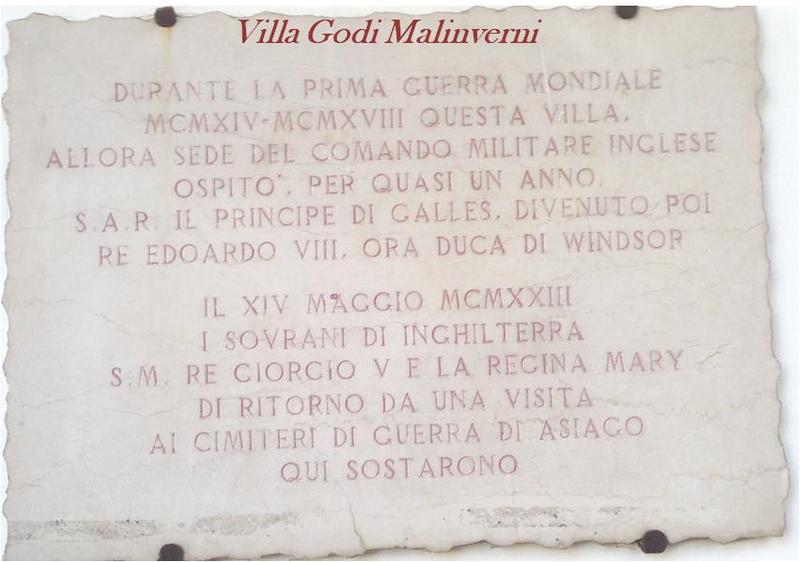During the Great War many villas and historic homes were important military centers. Their position, often in the hills, made these villas very safe, due to the limited access. From these points the commanders could coordinate and plan their actions of military defense and attack against the Austrians.
Villa Godi Malinverni 1917-1918
Even Villa Godi Malinverni had an important role during this historical moment, as the general headquarters for the British army. Their position allowed them to control the area from the Astico Valley to Arsiero, which also facilitated the protection and restricted the access routes. This way the British command could easily coordinate the 36,000 men deployed to the front, hence supporting the Italian army after the disaster at Caporetto in 1917.
The Prince of Wales, later to become King Edward VIII, stayed at Villa Godi Malinverni for almost one year, as he was very interested to know what was really happening at the Italian front. The future king of England arrived at Lugo di Vicenza in March 1918.
Edward VIII- The future King at Villa Godi Malinverni, Lugo di Vicenza
Edward VIII was nominated Prince of Wales in 1911 and was first in line to the British throne. In 1918 he arrived at Villa Godi Malinverni, before meeting and falling in love with his bride-to-be Wallis Simpson, and showed interest in the local girls while writing passionate love letters to Mrs Freda Dudley Ward ( as stated in the book written by Vallman and Brazzale). From the villa at the foot of the mountains of Asiago, the Prince of Wales would wake up early in the morning to visit the various military bases and then head over to the airport at Villaverla and fly over the territories under their supervision.
His stay in Villa Godi Malinverni lasted several months and is remembered today thanks to a plaque situated in the Villa placed during the visit of King George V and Queen Mary, who then went on to visit the English cemeteries at Asiago and Granezza.
Historical Background
The Great War
On the 28th June 1914, Crown Prince Franz Ferdinand of Austria was assassinated at Sarajevo. The killing caused unexpected political implications and soon the situation deteriorated. This caused great grief for Franz Joseph I of Austria and allowed him to use this as an excuse to declare war against the Serbians , as it was his dream to extend his empire into the Balcans. On August 3rd 1914 the Salandra Government declares its neutrality.
The Involvement of Italy in WWI
Italy becomes involved in the Great War after signing the secret Treaty of London in April of 1915, together with Britain, France and Russia.
In the months to follow Italy prepares to enter the war with the Triple Entente. The victory would bring to Italy the control of Trentino, South Tyrol and Trieste, Gorizia and part of Istria and Dalmatia on the eastern border.
…
On May 23rd 1915, the Salandra government announces that Italy will be joining the war.
…
The Duke of Avarna, Italian Ambassador in Vienna, submitted to the Austro-Hungarian Foreign Minister of War the following statement: ".... The Government of the King, will do everything in its power to defend the rights and interests of Italians, and will not neglect its duty to take action against any threats in the present and future measures that are imposed by the events in order to achieve the national aspirations. H.M. the King declares that Italy is considered in a state of war against Austria-Hungary as from tomorrow…..”
STRAFEXPEDITION- punitive expedition 1916
From May 15th to July 27th – the Greatest offensive against Italy
The front is stormed on May 15th 1916. Commander Conrad, guiding the Austrian army, begins to advance taking over Arsiero, Asiago and heading towards Schio and Bassano del Grappa. Fortunately a quick reinforcement at the front prevented them conquering the plain. On June 16th the army counter attacked and by July 24th 1916, the Italian army re-conquered part of the lost territory. Both sides suffered heavy losses: 83,000 Austrians against 147,000 Italians.
|




